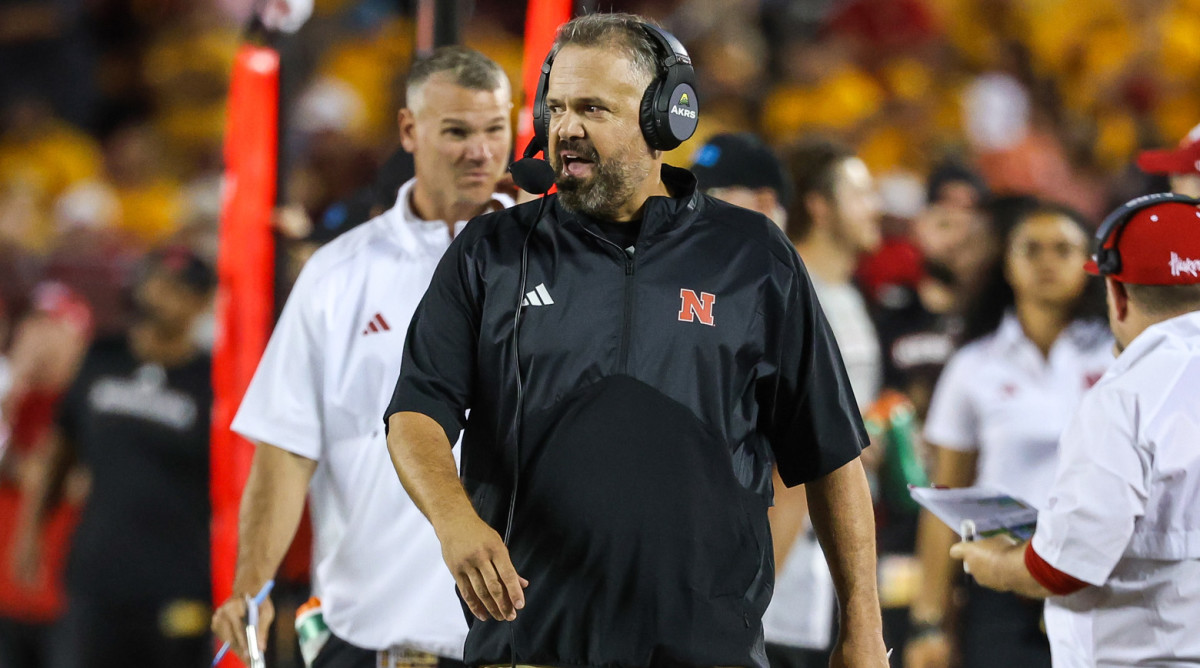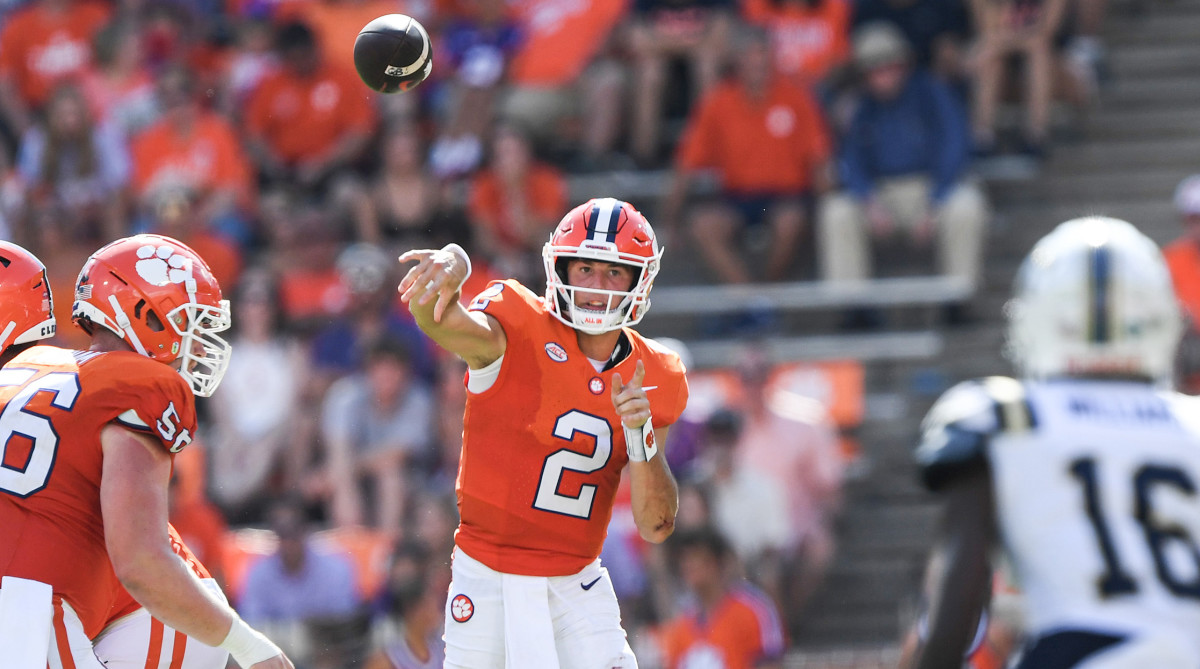Nebraska, Clemson Among Teams That Should Be Smashing the Panic Button
Forty names, games, teams and minutiae making news in college football (Turnover Tires, an extremely on-brand MAC thing, sold separately in Akron):
First Quarter: The Mess at MSU | Second Quarter: SEC Stinks
Third Quarter: Checking the panic meter
It’s never too early to lose your mind over your team’s slow start to the season. The Dash checks in on a few stressful situations outside the SEC (which was largely covered in the Second Quarter) and assesses how real the panic is.
Nebraska (21). Record: 0–2. Panic meter: high. Let’s just say that Colorado’s first-year coach provided a handy compare/contrast for Matt Rhule, and the result wasn’t pretty.

Under Scott Frost, the Cornhuskers turned bad season starts into an art form. Rhule was supposed to improve that, but so far it is a case of same suckage, different coach. Nebraska has wasted a couple of good defensive efforts with turnover-ridden offensive performances, which strongly suggest that Rhule doesn’t have a reliable quarterback on the roster.
The Cornhuskers have lost eight turnovers, most of any team in the nation that has played two games, and their minus-six turnover margin also is No. 133 out of 133. Georgia Tech transfer Jeff Sims has thrown four interceptions and lost two fumbles, which means his turnover-to-touchdown drives ratio is 3-to-1. Not ideal. Yet Rhule is sticking with Sims for Nebraska’s home opener against Northern Illinois on Saturday, which isn’t a ringing endorsement of backups Heinrich Haarberg and Chubba Purdy. When 2022 starter Casey Thompson transferred in early May to Florida Atlantic, it robbed Rhule of reliable depth at the position.
Wisconsin (22). Record: 1–1. Panic meter: moderate. The Badgers messed around and found out what road trips to the Palouse are like. They lost 31–22 to a Washington State team that is 20–9 at home since 2017 and has covered the spread 11 of its last 13 there. Still, this was a disappointing performance by Wisconsin, which never led. That followed a fairly lackluster opening win over Buffalo.
As some feared, star running back Braelon Allen hasn’t found his niche in the new Phil Longo offense. As promised, he’s been used more in the passing game—but it’s not working. He has 13 catches for just 37 yards, which is the lowest yards per catch among the top 100 receivers in the country. But the bigger concern is a defense that ranks 11th in the Big Ten, after not finishing worse than fourth in the previous 14 years.
(The Big Ten Panic Bowl is set for Nov. 18, Nebraska at Wisconsin.)
Texas Tech (23). Record: 0–2. Panic meter: semi-high. The Red Raiders were the buzz team of the Big 12 heading into the season, a popular pick to be the Next Program Up in a conference that has rotated six teams through its championship game the last three seasons. That optimism ran out of breath in Laramie in the opener, a 35–33 upset loss to Wyoming, then hit another wall in a 38–30 loss to Oregon in Lubbock.
There are a couple of mitigating factors to keep in mind here: Scheduling a road opener at Wyoming is asking for it (the Cowboys have won five of those in a row, three of them upsets), and Oregon is very good. The more granular concern is that Tech has given away leads in both games—up 17 on Wyoming and up nine on Oregon heading into the fourth quarter. Joey McGuire needs his defense to tighten up.
Baylor (24). Record: 0–2. Panic meter: high. The stunning opening loss to 27.5-point underdog Texas State got worse when the Bobcats followed that up by scoring 29 fewer points and producing 199 fewer yards in a loss to UTSA. The Bears showed some resolve in Week 2 by playing Utah to the wire, but they also failed to take advantage of the Utes’ continued loss of quarterback Cam Rising to injury.
Of course, Baylor was dealing with its own QB injury, with Blake Shapen replaced by Sawyer Robertson. Robertson completed just 12 of 28 passes for 218 yards and two interceptions, the latter of which set up the Utes’ winning touchdown. The Bears badly need Shapen (MCL injury) back in the lineup by Sept. 23, when Texas comes to town to open Big 12 play.
(Go ahead and circle Texas Tech at Baylor on Oct. 7 as the Big 12 Panic Bowl.)
Pittsburgh (25). Record: 1–1. Panic meter: semi-low. Pitt did what it does, no-showing a game as a solid home favorite in the first half of the schedule. This year it was Cincinnati as a 6.5-point favorite; in previous years it was Georgia Tech (22-point favorite in 2022), Western Michigan (14.5-point favorite in ’21) and North Carolina State (14-point favorite in ’20). The Panthers have gone on to winning records in all those seasons.
Pitt will need better from its offense going forward, from an offensive line that allowed five sacks, quarterback Phil Jurkovec (who was 10-of-32 passing) and a receiving corps that didn’t make enough plays. The panic meter will rise appreciably if the Panthers lose the Backyard Brawl on Saturday to West Virginia.

Clemson (26). Record: 1–1. Panic meter: semi-high. When the Tigers followed up their error-ridden opening loss to Duke by falling behind FCS Charleston Southern 14–7, the boos were audible in Death Valley. Quarterback Cade Klubnik had a couple more forehead-smacking turnovers, one a mishandled snap that was returned to the Clemson 1-yard line, the other an up-for-grabs pick-six. The Tigers wobbled into halftime up 24–17 before turning the game into a beating in the second half.
After five turnovers in two games, Clemson has one more week to get its stuff together before Florida State visits Sept. 23.
Boston College (27). Record: 1–1. Panic meter: semi-high. When the Eagles got a strip sack with 70 seconds left to hold off Holy Cross on Saturday, an ugly 0–2 start was averted. The Crusaders are a high-level FCS team, but still—that’s not the kind of team Boston College should be sweating it out against late in the game. The fact that it followed a home loss to Northern Illinois—which then went on to lose to Southern Illinois—underscores how shaky the Eagles are heading into consecutive games against Florida State and Louisville.
Boston College scheduled embattled Jeff Hafley for success this season, with four non-conference games against non-Power 5 opposition, but reaching bowl eligibility will still be a steep climb.
Connecticut (28). Record: 0–2. Panic meter: high. The Huskies progressed in their first year under Jim Mora, from flatlined to 6–7. Now they’re showing signs of regression in a season that was billed otherwise. The season-opening loss to North Carolina State was by no means terrible; following that up with a 21-point drubbing from Georgia State was by all means terrible. UConn trailed 28–0 in the third quarter against a team expected to be a Sun Belt Conference also-ran.
There are plenty of soft spots remaining on the Huskies’ independent schedule, but even those games will be difficult if they play like they did in Atlanta on Saturday.
Boise State (29). Record: 0–2. Panic meter: moderate. The Broncos are 0–2 for the first time since 2005, but that’s more a product of the schedule than anything. Opening at Washington was pretty much a guaranteed loss, and catching Central Florida in Week 2 was a challenge. The Knights won that game on a 40-yard field goal at the gun. (UCF kicker Colton Boomer, he of “kickin’ bombs and kissin’ your moms” high school yearbook fame, also made field goals of 50 and 55 yards in the game.)
The Broncos are averaging only 17.5 points per game. Quarterback Taylen Green, expected to take a leap forward as a sophomore, hasn’t launched this season. He’s completed less than 50% of his passes with three interceptions and two touchdowns. Boise still might be the best team in the Mountain West, but it needs to hit its stride just as last year’s team did after a 2–2 start.
UAB (30). Record: 1–1. Panic meter: semi-low but higher than nonexistent. Trent Dilfer was a way-outside-the-box hire who took over a wholesale remodeling job. On a scale of 1 to Deion Sanders, give him a 3.5 so far. After an opening win over FCS North Carolina A&T, the Blazers were blitzed by Georgia Southern, 49–35. UAB fumbled on its first play of the game, turned it over on downs in its own territory on its next possession, missed a 35-yard field goal on its third and trailed 14–0 after one quarter. There weren’t many defensive stops thereafter, either.
November is a winnable month for UAB (FAU, Navy, Temple, North Texas). But we’ll see where the Blazers are once they get there.
